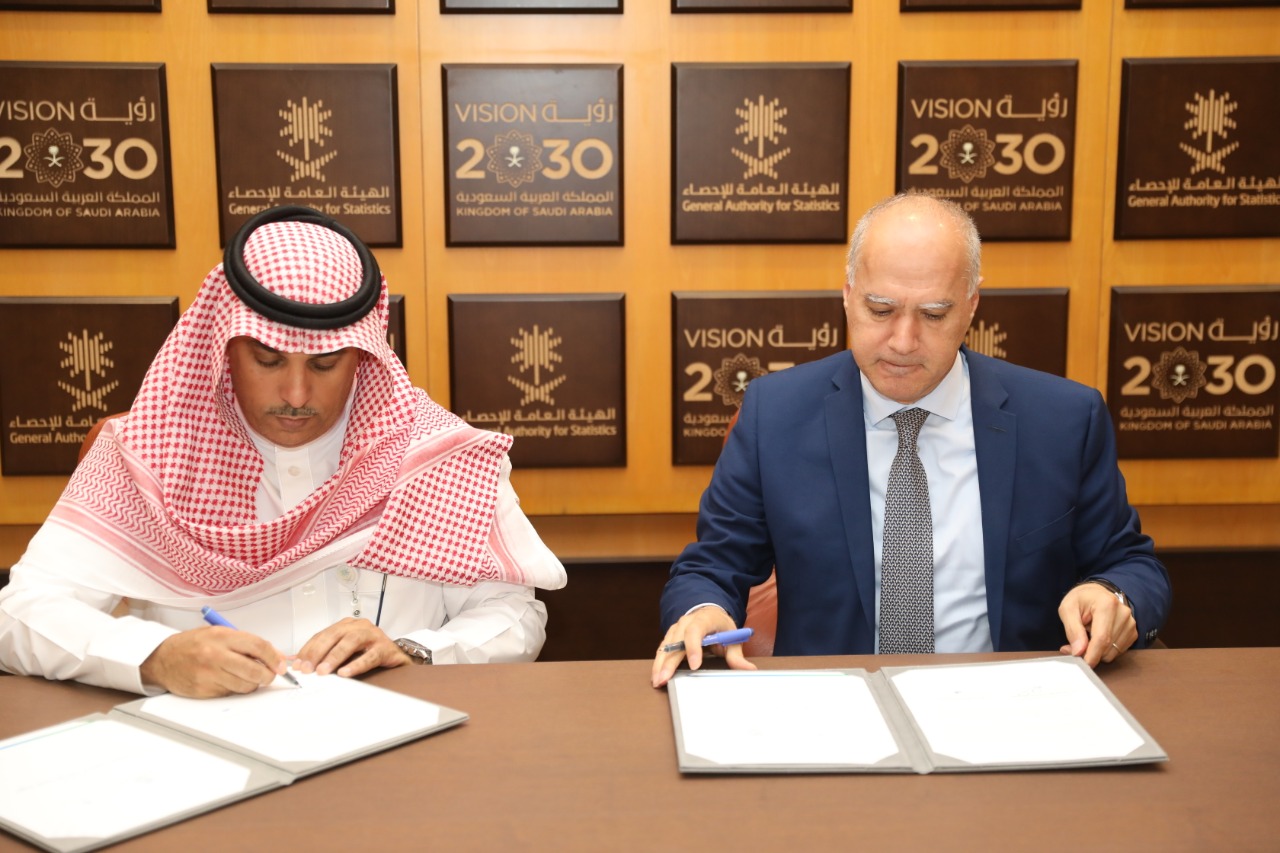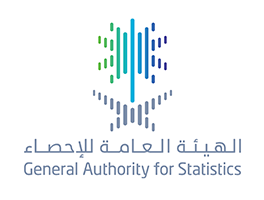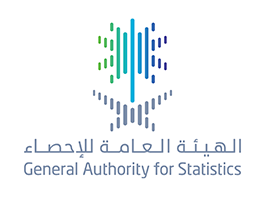
"الإحصاء" والبنك الدولي: شراكتنا تدعم الجهات الحكومية في تبادل البيانات الإحصائية وإبراز جهودها على المستوى الدولي
Signing a MoU to enhance Use of Data
“GASTAT” & World Bank: Our collaboration Supports Government Entities in the Exchange of Statistical Data and highlighting their efforts at the international level
The General Authority for Statistics (GASTAT) and the World Bank signed on Monday 5/11/1440 H (8/7/2019) a memorandum of understanding to regulate statistical data exchange and enhance the joint work to support government entities. The MoU regulates the provision of data and statistics on Saudi Arabia to the World Bank, the classification of statistical data, whether the survey data produced by GASTAT from economic and household surveys or data of administrative records collected by GASTAT from government entities. The agreement also includes the mechanisms for requesting data from sources, technical responsibilities, intellectual property rights and organization aspects of publication.
HE Dr. Fahad Bin Sulaiman Al-Tekhifi, President of GASTAT, affirmed that the organization of data exchange with international organizations is one of the strategic tracks of the work of GASTAT, which stems from Saudi Arabia’s position which is led by government entities under the guidance of the Custodian of the Two Holy Mosques and His Royal Highness the Crown Prince. Furthermore, it reflects the role of GASTAT in increasing the pace of coordination and collaboration with the international organizations concerning data and statistical indicators of Saudi Arabia. Moreover, it reflects the importance of the World Bank’s work in highlighting these indicators in international comparison programs and in carrying out studies and research relevant to the common development aspects of all countries of the world.
The Regional Director of the World Bank in the Gulf Region, Mr. Essam Abu Sulaiman, asserted that the collaboration with the General Authority for Statistics as the official statistical body of Saudi Arabia comes in order to highlight the efforts undertaken by Saudi Arabia in various fields of development, and in response to the increasing demand for statistical data, whether survey data or data from records released by government entities. He also added that the collaboration with the Saudi statistical body will play an active role in the data request operations and provision to the World Bank, and ensure their unification according to international classifications and standards. The Regional Director of the World Bank commended the procedures carried out by GASTAT which are in accordance with the international requirements and methodologies of statistical work applicable in all countries.
The World Bank is a strong partner in the GCC for more than 50 years. Government entities in the GCC have benefited from the World Bank's global development knowledge and expertise through its technical assistance programs. These include the activities in the GCC in key areas that the Bank has extensive international technical expertise in them, including improving service delivery, encouraging diversification of economic activity, strengthening governance, strengthening social protection systems and pensions. The World Bank is also working with the General Secretariat of the Gulf Cooperation Council to address interrelated issues, particularly in environmental protection.
GASTAT Releases Real Estate Price Index for Q2, 2019
GASTAT Releases Real Estate Price Index for Q2, 2019
General Authority for Statistics (GASTAT) released the report of Real Estate Price Index for Q2 of 2019. The report was published on the official website of GASTAT www.stats.gov.sa.
The real-estate price index recorded an increase by (4.0%), compared to the previous quarter (Q1, 2019), where its indicator reached (80.4) in Q2, 2019, compared to (80.1) in Q1, 2019. This increase can be attributed to the changes in the main sectors composing the indicator, where housing sector in addition to commercial sector showed an increase by (2.0%) and (8.0%), respectively, whereas agricultural sector edged down to (1.0%), compared to Q1 of 2019.
In detail, residential sector witnessed an increase in residential lands as well as apartments, reaching (0.2%) and (0.5%), respectively in Q2, 2019 compared to the previous quarter. However, a decrease was recorded in three groups: residential buildings (0.3%), villas (2.7%), and houses (0.3%). Regarding commercial sector, commercial land plots and commercial centers rose by (0.8%) and (2.1%), respectively, while exhibitions (shops) dropped to (1.9%). At the level of agricultural sector, agricultural lands fell to (0.1%).
It is worth noting that the index is based on register-based data of real-estate transactions available at the Ministry of Justice. It is an essential tool that supports entities making economic and statistical decisions regarding the movements of real - estate prices and future forecasts during different periods of time. The index has three main sectors consisting of several types of real estate classes: housing sector which includes (plot of land, building, villa, apartment, and house), commercial sector including (plot of land, building, exhibition/commercial center and shop), in addition to agricultural sector with one category which is the agricultural land.

الهيئة العامة للإحصاء: تصدر التقرير الشهري للرقم القياسي لأسعار المستهلك لشهر يونيو 2019م
GASTAT: releases Consumer Price Index(CPI) Monthly Report for June,2019
General Authority for Statistics (GASTAT) released its monthly report of CPI in Saudi Arabia for June, 2019. The report was published on its official website www.stats.gov.sa. CPI index increased by (%0.2) compared to last month (May,2019).
GASTAT’s report indicated that the consumer price index CPI in Saudi Arabia increased from (105.7) in May,2019 to (105.9) in June,2019 with (%0.2) change.
As a matter of fact, the report attributed this increase to the increase of the five sections composing it, which are: personal goods and services section with (%1.8), culture and entertainment section with (%1.5), transportation section with (%0.6), restaurants and hotels section with (%0.6), and food and beverages section with (%0.2).
In contrast, three of the main sections witnessed a decline, which are: housing, water, electricity, and gas section with (%0.4), clothing and shoes section with (%0.2), finally home furnishing and equipment section with (%0.1).
On the other hand, health, telecommunication, education, and tobacco sections remained stable with no change.

الهيئة العامة للإحصاء تصدر نتائج مسح الثقافة والترفيه الأسري لعام 2018م
Statistical Survey Issued by GASTAT for the First Time
GASTAT Releases Results of Household’ Culture and Entertainment Survey for 2018
General Authority for Statistics (GASTAT) released results of “Household’ Culture and Entertainment Survey 2018”. The survey was published on its official website www.stats.gov.sa. This survey complements the new statistical products implemented by the Authority to meet the local and international requirements of statistical data. It is first-of- its- kind survey in the field of household culture and entertainment, which will be conducted on a periodical basis every three years by GASTAT in line with the international methodology of culture statistics. The fundamental objective of the survey is to support decision makers, policy makers, researchers, and those who are interested in up-to-date data on statistics of household culture and entertainment in Saudi Arabia by (gender, nationality, educational status, age, and marital status).
(35.36%) of Saudi Arabia’s population (Saudis and non-Saudis) had a home library during the 12 months. In detail, the percentage of reading books among Saudi individuals (15 +) was (58.18%) during the 12 months. The percentage of both (Saudi and non-Saudi) individuals (15+) who read newspapers or magazines recorded (53.96%), out of total population of Saudi Arabia. For Saudis, the total percentage of Saudi individuals (15+) who read newspapers or magazines accounted for (59.46%) during the 12 months, where (67.14%) of them were Saudi males, and (51.48%) of them were Saudi females. However, the percentage of reading electronic newspapers or magazines was (66.58%), out of the total number of reading newspapers or magazines, while the percentage of reading printed newspapers or magazines reached (5.77%). As for both types, the total percentage of reading electronic or printed newspapers or magazines registered (27.65%), during 12 months, according to the results of the survey.
(42,40%) of Saudi individuals (15+) visited theme parks for entertainment or culture as the most visited places in the residence of place during 12 months. However, cultural landscapes are the most visited places for Saudi individuals (15+), recording a percentage of (57.21%), out of total Saudis who traveled inside Saudi Arabia to visit cultural or entertainment places during the 12 months. Likewise, cultural landscapes were one of the most visited places for Saudi individuals (15 +), where the total number of Saudis who traveled outside Saudi Arabia to visit cultural or entertainment places during the 12 months was (70.03%), based on the survey’s results.
Watching television or listening to radio stations recorded the highest percentage as the most cultural and entertainment activities practiced by Saudi individuals during their free time at the level of Saudi Arabia, reaching (67.02%), out of the total number of Saudis who engaged in cultural or entertainment activities during the (12) months.
GASTAT is pleased to provide its clients of data users with the detailed results of the survey. The results will be available on its website, containing about 40 statistical indicators.
